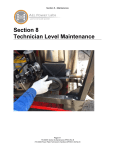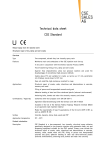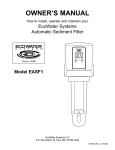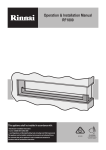Download GASIFIER PILOT PROJECT OPERATION MANUAL
Transcript
GASIFIER PILOT PROJECT OPERATION MANUAL REVISIONS AND PROJECT RECOMMENDATIONS Author: SNV Country: Burkina Faso Sector: Renewable energies CONTEXT O BSE RV ATIO NS A ND RE CO MMEND ATIONS A pilot gasification system has been installed at the Wouol cashew transformation facility in Dakoro. The goal of this study was to observe how the gasifier was actually being used and to update the operation manual accordingly. Additionally, it was desired to determine some operational problems and potential solutions to ensure the success of future projects. I have attached a revised operation manual, presented in French to ensure its accessibility. I have also attempted to summarize the key points of the manual visually, in a poster format. Below, I have summarized the main steps involved in gasifier operation. I will discuss significant changes from the old operation manual, as well as problems encountered during operation. Charging the Gasifier Gasifier charging is done every morning as follows: The top steel plates are opened. One bucketful (roughly 4kg) of smouldering cinders is added to the gasifier, followed by 20kg of cashew shells, one shovel-full of burning embers, and 20kg of additional cashew shells. The steel plates are then closed. If the gasifier was not discharged since its last use and combustion has not ceased (i.e., a fire has continued to smoulder within the gasifier), then only 20kg of cashew shells are added during the charging step. Start-Up The water in the pressure release tank is topped up, if required. All plugs are removed from the side of the gasifier, the gas valve is opened and the ventilators are set up. Both ventilators are turned on simultaneously, both fully open. The plugs are replaced within 1 to 2 minutes of the ventilators being turned on. We must then wait for 5 to 20 minutes (or up to one hour if the gasifier has just been discharged) as the gasifier heats up. Once the gasifier has heated sufficiently, a clean-burning syngas will start being produced and the burner can be lit. The ventilators can be adjusted to control the size of the flame in the burner. During start-up, smoke will be produced. This is likely the result of the prevailing combustion process while the gasifier heats up and is therefore unavoidable. Once syngas starts being produced and the burner is lit, no more visible smoke is produced. Currently, the smoke produced during start-up can make it difficult to work around the gasifier. To help mitigate this problem, the gas valve is left open during start-up, which directs smoke through the burner and (in part) up through the boiler’s chimney. Smoke still clouds the area around the gasifier, but at least some of it is directed away. It might be worth installing a sealed chimney (attached to the openings on the side of the gasifier) which will direct all of this smoke upwards and away from the workspace. François Pinta, of CIRAD, also suggested that we consider using a different type of biomass during start-up. He has worked with a nearly identical gasifier, and his experience has shown that rice husks or dry leaves can heat the gasifier much faster and produce less smoke. Start-up time can be reduced from one hour to twenty minutes. This of course depends on the availability of alternate fuel sources. The smoke produced during start-up can be nearly eliminated by not discharging the gasifier on a daily basis. Non-daily discharge has the advantage of significantly speeding up the start-up process and reducing smoke discharge because the gasifier does not need to heat back up from ambient temperature. A non-discharged gasifier can be up and running within 5 minutes of turning on the ventilators, a process which otherwise takes up to 1 hour. In Dakoro, an average of 3 to 4 days would pass before the gasifier was discharged. However, we only used the gasifier for a few hours per day; more consistent use will require more frequent discharge as residues will build up faster. It should also be noted that keeping the gasifier heated at all times may reduce the gasifier’s operational lifetime, a possible issue which requires further investigation. SNV Netherlands Development Organisation 1 Case Studies 2013 If the gasifier is not properly cleaned or wet cashew shells are used, even larger amounts of smoke are produced during start-up. The smoke was so bad at times that nearby residents complained. This is the result of the heat loss associated with burning a damp fuel and the reduced efficiency of an unclean gasifier. It is therefore important to keep the gasifier clean and well-maintained and to use only well dried cashew shells as fuel. If it is intended to use the gasifier during the rainy season, then cashew shells should be dried and stockpiled in a covered area during the dry season. Figure 5 - Smoke Produced by Wet Cashew Shells Re-Charging the Gasifier When the gasifier stops producing a clean-burning syngas (i.e. the flame in the burner is extinguished), 20kg of additional cashew shells are added to the reactor: The lower steel plate is opened fully. Roughly 7kg (one bucketful) of cashew shells are poured into the charging chamber. The top steel plate is quickly opened and closed to allow the cashew shells to fall into the gasifier. This is repeated 2 or 3 times, until roughly 20kg of cashew shells have been added to the gasifier. This is sufficient fuel to produce more syngas and the burner can be relit within a few minutes. Typically, 20kg of cashew shells will produce a clean-burning syngas for roughly 1.5 to 2 hours. Discharging the Gasifier We must first extinguish the fire within the gasifier. This is accomplished by simply opening the top steel plates and removing all of the plugs on the side of the gasifier. The gasifier is then left until the combustion process has gone to completion and the fire within the reactor has died. Discharging is typically performed the following morning, once the gasifier has had time to cool. The top and bottom steel plates are then opened fully and a long stick is used to push all the residues out the bottom of the gasifier. The gasifier is hit with a hammer to break loose any residues stuck to the inside of the gasifier. This procedure is typically done twice a week. After the gasifier has been discharged, we proceed to the charging step, described above. As mentioned above, daily gasifier discharge is not required and is only recommended if the gasifier is being used for many hours per day or stops functioning correctly. Maintenance Before cleaning, the gasifier is allowed to cool and is discharged. The gasifier is then completely dismantled into its separate components. Oils which have collected in low spots (particularly the gas valve and the cyclone separator) are poured into containers. Due to a lack of proper cleaning tools and the constraints imposed by the gasifier’s design (particularly the thin grooves housing the sliding steel plates), cleaning is accomplished by scraping the gasifier components clean with lengths of rebar. Tar build-up in difficult to reach areas is burned off using a wood fire. After discussing the importance of regular maintenance, it has been decided to dismantle and thoroughly clean the Dakoro gasifier once per month, more often if the gasifier is not operating correctly. To emphasise the importance of proper cleaning and maintenance, upon my arrival in Dakoro, the gasifier was not functioning correctly: A clean-burning syngas was not SNV Netherlands Development Organisation 2 Case Studies 2013 being produced and the burner would not remain lit. Initially I was told that this was the result of one of the ventilators having been burnt out. Upon further inspection I found that the gasifier was clogged by residues and required cleaning. The gasifier was fully dismantled and cleaned. After cleaning, the gasifier performed as intended and the burner functioned without issue. Figure 1 – Dirty and Clean Gasifier The use of fire to clean the gasifier is undesirable, since this can embrittle the steel and shorten the gasifier’s life. The use of an organic solvent is one possible alternative, but this may prove costly and difficult to dispose of. A better solution would be to alter the gasifier’s design to facilitate cleaning: The sliding steel plates rest in narrow grooves which are particularly difficult to clean. By replacing the steel plates with a hatch, as discussed below, we can greatly ease the process of cleaning. In addition, proper cleaning tools, such as correctly sized steel brushes, should be provided. This will make cleaning easier and less likely to be neglected. With regards to maintenance, I am not certain that tar build-up is necessarily bad for the gasifier. Obviously, we do not want to allow large blockages which block airflow and prevent the proper function of the gasifier. However, a thin layer of tar coating the gasifier’s interior may protect the steel from corrosion and embrittlement. This is only conjecture and will require further investigation, but may lead to a different approach towards cleaning and maintenance. Currently, the oils recovered during gasifier maintenance are simply burned by locals for cooking. This resource may be used for some other application, but due to the limited amount of oil recovered, I do not believe that this is feasible. Notable Problems During gasifier operation, ash and tar will build up on the steel plates. This makes it very difficult to open and close the steel plates, as illustrated below. As a result, the two door charging system is not being used as intended, with both plates being opened simultaneously during charging of the gasifier. Later during my stay, one of the upper steel plates was jammed so severely that it was left open permanently. It was noted that this did not apparently affect the gasifier’s operation in any way. Therefore, I propose that the dual steel plate system be done away with. Instead, a single sliding plate should prove sufficient, or better, a swinging hatch that can be opened and closed with ease and which is more resistant to tar build-up. Similarly, the discharge steel plates can be successfully replaced by a single sliding plate or a swinging hatch. The danger with using a hatch is that poisonous CO gases are released into the air. There is a danger that someone breathes in concentrated CO gas while charging the gasifier, causing them to become dizzy and fall from the gasifier’s ladder, injuring themselves. These gases can be harmful or even fatal in large enough quantities, and must be treated with caution. SNV Netherlands Development Organisation 3 Case Studies 2013 Figure 2 – Steel Plate Difficulties Figure 3 - Swinging Hatch Rather than a hatch or sliding steel plate, I would like to propose a rotating hatch design, shown below. This design aims to simplify the charging process while limiting the gases released. The Steel Rim is designed to overlap the rotating hatch to allow the hatch to seal when it is closed and to allow the hatch to rotate in only one direction. A counterweight should hold the hatch closed during normal operation. Not pictured is a wheel attached to an axle, which can be used to turn the hatch. If the axle is attached to the top side of the hatch then it should not get clogged with tar and ash. I am not certain about the feasibility of this design, but it may be worth considering. Figure 4 - Rotating Hatch One other noted issue is that currently, oil and smoke leak out of the gas valve and the piping flanges during operation. If the gas valve were rotated 180˚ to be oriented upwards, the uncontrolled leakage of oils could be halted. Also, installing a seal on all flanges will limit smoke leakage, although this may be an unnecessary additional cost since small amounts of smoke leakage are unlikely to have a negative impact so long as the gasifier is located in a well-ventilated area. In any case, these suggestions may be considerations for future gasifier designs. SNV Netherlands Development Organisation 4 Case Studies 2013 Figure 5 - Oil and Smoke Leaking From Gas Valve Operation Manual Changes One particularly notable variation from the manual was the operation of the ventilators. According to the operation manual, only one ventilator should be running fully open at any time. In Dakoro, both ventilators were run fully open throughout start-up and were only adjusted if the burner flame was too intense. This method of operation is relatively simple and produces a desirable result. The original operation manual was quite lengthy and cumbersome. I have done my best to simplify and streamline the original operating procedures. I have also altered the procedures to reflect the true methods of operation which are being employed successfully in Dakoro. The revised manual is attached at the end of this document. The operation manual is written in French and a hard copy should be provided to operators in the future. Currently, there is no hard copy of the operation manual in Dakoro, and digital copies are useless in an area without electricity. I have also attempted to summarize the operation procedures visually, in a series of pictures. The intent is to provide an easy reference for the gasifier’s operation. Social Integration With regards to social integration, I believe the gasifier has been largely accepted by the operators in Dakoro. The gasifier makes their jobs easier and greatly speeds up the steaming process. Unfortunately, the gasifier-powered drying chambers were not yet operational during my visit, so I am uncertain about their effectiveness, but I imagine that they will operate similarly to the gas driers which are currently being used and can be easily integrated. As I see it, there are two main challenges facing gasifier integration: First is the relative complexity of the gasifier. If something goes wrong, it can be difficult to find and correct the problem, especially if local operators do not understand the inner workings of the gasifier. Providing a hard copy of the manual will definitely help with this problem, as will a comprehensive, hands-on training program for all the operators. Second are the maintenance requirements. Maintenance is a lengthy, labour-intensive process, which can be difficult to enforce. One possible solution is to set aside one or two days per month which will be dedicated towards maintenance. In the days leading up to these ‘shut-downs’, steamed cashews can be over-produced to allow the other processing steps to continue uninterrupted. It is important to establish a regular maintenance schedule which can be implemented without interrupting the facility’s normal operation. Also, as mentioned above, proper cleaning tools will help with the cleaning process. It should be noted that the difficulty with the steel plates (discussed above) is regarded as the largest problem with the gasifier by local operators. Sometimes one steel plate will simply be left open to avoid having to struggle with opening and closing it. I believe it is imperative that this design issue be addressed, since it greatly increases the difficulty of gasifier operation and may lead to the technology being abandoned. Also mentioned above is the smoke produced during start-up, which can be irritating to workers and nearby residents. This can be limited by using dry cashew shells, performing non-daily discharge and directing smoke through the boiler’s chimney. However, even using these measures, a noxious smoke still clouds the area around the gasifier, making it difficult and unhealthy to work there. It might be worth installing a SNV Netherlands Development Organisation 5 Case Studies 2013 sealed chimney on the side of the gasifier to direct this smoke upwards and away from the area. Below, I have summarized my most important findings: S UMMA RY 1. 2. 3. 4. 5. 6. 7. 8. It is important to establish a regular cleaning and maintenance schedule. In Dakoro, the gasifier is now dismantled and thoroughly cleaned once per month. This schedule may need to be modified to reflect the gasifier’s use. Modified gasifier design and proper cleaning tools will ease this process. The sliding steel plates are easily jammed by tar and ash and future gasifier designs would benefit from a swinging or rotating hatch. Having the reactor open to air for short periods of time does not appear to adversely affect the gasifier’s operation, so an airlock system is not required. This issue presents a major obstacle and must be addressed. Currently, thick, noxious smoke is produced during start-up. It may be worth installing a chimney on the side of the gasifier to direct this smoke away from the workspace. Alternately, using dry leaves or rice husks can speed up the start-up process and reduce smoke emissions. It is important to use dry cashew shells for fuel to reduce smoke. It may be required to dry and stockpile cashew shells for use during the rainy season. Daily discharge is not required and in fact slows start-up and increases the amount of noxious smoke produced. Recommended discharge frequency depends on gasifier use and residue build-up and must be determined individually for each operation. In Dakoro, the gasifier was discharged every 3 to 4 days, using the gasifier for 3 hours per day. The gas shutoff valve currently leaks smoke and oil. By rotating the valve 180˚ to face upwards, oil leakage can be prevented. I do not believe that gasifier integration is a large issue, but operators should be provided with thorough training and a hard copy of the user’s manual to ease the process. Changes in gasifier operation practices are presented in the revised manual. I have also attempted to summarize the manual in a series of visual aids. SNV Netherlands Development Organisation 6 Case Studies 2013




















